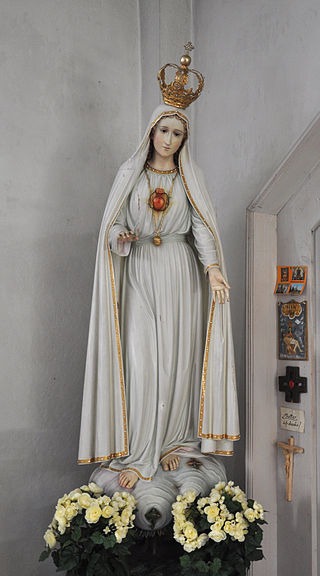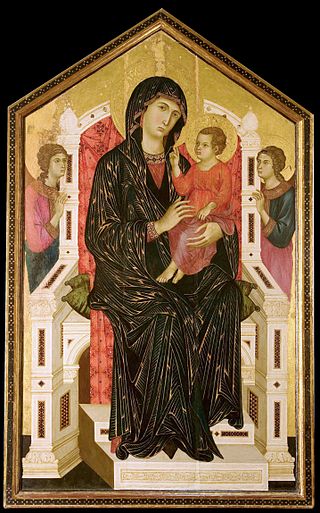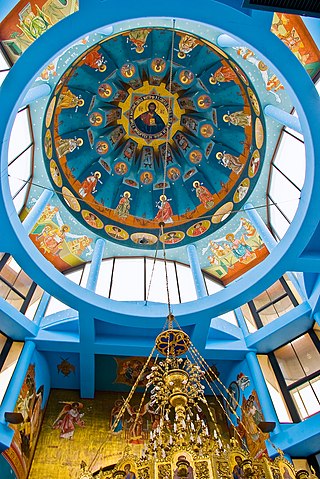
Our Lady of Fátima is a Catholic title of Mary, mother of Jesus, based on the Marian apparitions reported in 1917 by three shepherd children at the Cova da Iria in Fátima, Portugal. The three children were Lúcia dos Santos and her cousins Francisco and Jacinta Marto. José Alves Correia da Silva, Bishop of Leiria, declared the events worthy of belief on 13 October 1930.

The Three Secrets of Fátima are a series of apocalyptic visions and prophecies reportedly given to three young Portuguese shepherds, Lúcia Santos and her cousins Jacinta and Francisco Marto, by a Marian apparition, starting on 13 May 1917. The three children claimed to have been visited by the Virgin Mary six times between May and October 1917. The apparition is now popularly known as Our Lady of Fátima.

Catholic Mariology is Mariology in Catholic theology. According to the Immaculate Conception taught by the Catholic Church, she was conceived and born without sin, hence Mary is seen as having a singular dignity above the saints, receiving a higher level of veneration than all angelic spirits and blessed souls in heaven. Catholic Mariology thus studies not only her life but also the veneration of her in daily life, prayer, hymns, art, music, and architecture in modern and ancient Christianity throughout the ages.

The Immaculate Heart of Mary is a Roman Catholic devotional name used to refer to the Catholic view of the interior life of Mary, mother of Jesus, her joys and sorrows, her virtues and hidden perfections, and, above all, her virginal love for God the Father, her maternal love for her son Jesus Christ, and her motherly and compassionate love for all mankind. Traditionally, the Immaculate Heart is depicted pierced with seven swords or wounds, in homage to the seven dolors of Mary and roses, usually red or white, wrapped around the heart.

The consecration of Russia to the Immaculate Heart of Mary by a reigning pope was requested during a Marian apparition by Our Lady of Fátima on 13 July 1917, according to Lúcia dos Santos, one of the three visionaries who claimed to have seen the apparition. Sister Lucia said that at different times the Blessed Virgin Mary had given her a message of promise that the consecration of Russia to the Immaculate Heart of Mary would usher in a period of world peace.

Minor Basilica of the Immaculate Heart of Mary, is a titular church in Piazza Euclide, Rome. It was built by the architect Armando Brasini (1879–1965). Its construction began in 1923 with the design of a Greek cross inscribed in a circle with an articulated facade, and completed before 1936, the year in which it was made a parish church and granted to the Congregation of Missionary Sons of the Sacred Immaculate Heart of Mary, usually known as the Claretian Missionaries. A grand dome was planned, but never realized; a smaller drum was completed in 1951.

Federico Tedeschini was an Italian cardinal of the Holy Roman Church who served as papal datary in the Roman Curia from 1938 until his death, and was elevated to the cardinalate in 1933 in pectore by Pope Pius XI.
Auspicia quaedam is an encyclical of Pope Pius XII on worldwide public prayers to the Virgin Mary for World peace and the solution of the problem of Palestine.
Ad Apostolorum principis is an encyclical of Pope Pius XII on Communism and the Church in China. It describes systematic persecutions of bishops, priests, religious and faithful and the attempts of the government to establish a patriotic Catholic Church, independent of Rome.
Cupimus imprimis is an apostolic letter of Pope Pius XII to all the faithful in China regarding their persecutions and the persecution of the Catholic Church.
Pope Pius XII and Russia describes relations of the Vatican with the Soviet Union, Russia, the Eastern Orthodox Church, and the Eastern Catholic Churches resulting in the eradication of the Church in most parts of the Soviet Union during the Stalinist era. Most persecutions of the Church occurred during the pontificate of Pope Pius XII.

The theology of Pope Pius XII is reflected in his forty-one encyclicals, as well as speeches and nearly 1000 messages, during his almost 20-year pontificate. The encyclicals Mystici corporis and Mediator Dei advanced the understanding of membership and participation in the Catholic Church. The encyclical Divino afflante Spiritu began opening the door to historical-critical biblical studies. But his magisterium was far larger and is difficult to summarize. In numerous speeches Catholic teaching is related to various aspects of life, education, medicine, politics, war and peace, the life of saints, Mary, the mother of God, things eternal and temporal.

Throughout history, Catholic Mariology has been influenced by a number of saints who have attested to the central role of Mary in God's plan of salvation. The analysis of Early Church Fathers continues to be reflected in modern encyclicals. Irenaeus vigorously defended the title of "Theotokos" or Mother of God. The views of Anthony of Padua, Robert Bellarmine and others supported the doctrine of the Immaculate Conception of the Virgin Mary, which was declared a dogma in 1850.

The Mariology of the popes is the theological study of the influence that the popes have had on the development, formulation and transformation of the Roman Catholic Church's doctrines and devotions relating to the Blessed Virgin Mary.

Pope Pius XII consecration of the world to the Immaculate Heart of Mary took place on October 31, 1942. Pope Pius XII performed a Marian consecration, entrusting the world to the Virgin Mary, as Queen of Peace, through her Immaculate Heart.

Mariological papal documents have been a major force that has shaped Roman Catholic Mariology over the centuries. Mariology is developed by theologians on the basis not only of Scripture and Tradition but also of the sensus fidei of the faithful as a whole, "from the bishops to the last of the faithful", and papal documents have recorded those developments, defining Marian dogmas, spreading doctrines and encouraging devotions within the Catholic Church.

Le pèlerinage de Lourdes is the only encyclical of Pope Pius XII issued in French. It includes warnings against materialism on the centenary of the apparitions at Lourdes. It was given at Rome, from St. Peter's Basilica, on the feast of the Visitation of the Most Holy Virgin, July 2, 1957, the nineteenth year of his pontificate.

Eastern Catholic victims of Soviet persecutions include bishops and others among the tens of thousands of victims of Soviet persecutions from 1918 to approximately 1980, under the state ideology of Marxist–Leninist atheism.

The consecration and entrustment to the Virgin Mary is a personal or collective act of Marian devotion among Catholics, with the Latin terms oblatio, servitus, commendatio and dedicatio being used in this context. Consecration is an act by which a person is dedicated to a sacred service, or an act which separates an object, location or region from a common and profane mode to one for sacred use. The Congregation for Divine Worship and the Discipline of the Sacraments clarifies that in this context, "It should be recalled, however, that the term "consecration" is used here in a broad and non-technical sense: the expression is use of 'consecrating children to Our Lady', by which is intended placing children under her protection and asking her maternal blessing for them".
Pope Pius XII consecration to the Immaculate Heart of Mary may refer to:














